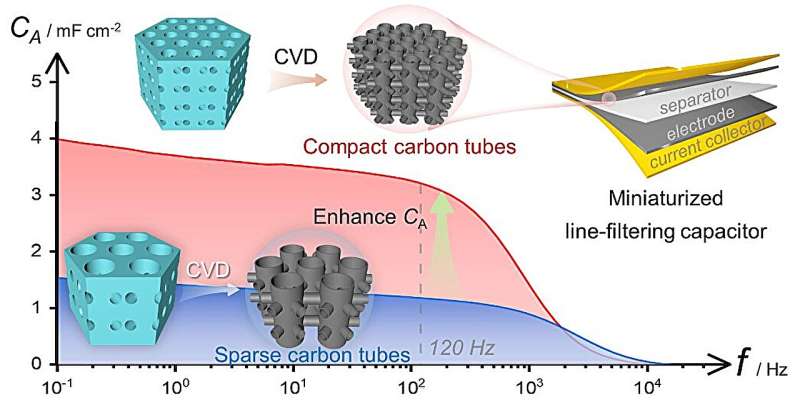This article has been reviewed according to Science X's editorial process and policies. Editors have highlighted the following attributes while ensuring the content's credibility:
fact-checked
trusted source
proofread
High density carbon tube nanoarray design miniaturize filter capacitors

A research team has constructed high-density three-dimensional carbon tube nanoarray electrodes for use in line-filtering capacitors, showcasing immense potential as high-performance miniaturized filter devices.
The research results were published in Nano-Micro Letters.
Filter capacitors are essential for turning fluctuating voltage signals into steady direct current. Aluminum electrolytic capacitors (AECs) are commonly used but are quite large and have limited capacitance, which makes it hard to shrink modern electronics.
Electric double-layer capacitors (EDLCs) have much higher energy density, making them a promising alternative for smaller filter capacitor applications. However, traditional carbon-based EDLCs have slow ion transport, making it difficult for them to achieve both high energy density and quick frequency response needed for line-filtering.
The team, led by Prof. Meng Guowen and Prof. Han Fangming from the Hefei Institutes of Physical Science of the Chinese Academy of Sciences, along with Prof. Wei Bingqing from the University of Delaware and Prof. Li Xiaoyan from Tsinghua University, conducted a systematic study aimed at precisely manipulating the pore structure of three-dimensional interconnected porous anodized aluminum oxide (3D-AAO) templates.
They achieved a remarkable feat by continuously tuning the vertical pore diameter of 3D-AAO from 70 to 250 nm and the inter-pore spacing from 100 to 450 nm. Leveraging these tunable templates, they fabricated 3D compactly arranged carbon tube (3D-CACT) nanoarray electrodes via chemical vapor deposition.
Specific surface area tests revealed that reducing both the pore diameter and inter-spacing significantly augmented the electrode's surface area.
The resultant 3D-CACT electrode-based device exhibited exceptional frequency response performance characterized by a phase angle of -80.2° at 120 Hz, an ultra-low equivalent series resistance of less than 0.07 Ω cm2, and a rapid resistance-capacitance time constant of 0.25 ms.
Notably, its specific areal capacitance at 120 Hz reached 3.23 mF cm-2, far surpassing that of commercial AECs (~0.08 mF cm-2) and previously reported aqueous sandwich-type line-filtering EDLCs. This underscores the 3D-CACT nanoarray's ability to facilitate efficient ion transport and offer abundant charge adsorption sites.
Furthermore, researchers demonstrated the scalability of their approach by connecting six and 10 sets of identical 3D-CACT-based EDLCs in series, successfully extending the capacitors' operating voltage while preserving their rapid frequency response and low loss characteristics.
To showcase the practicality of their invention, they employed 10 series-connected devices as filters, effectively converting various alternating current inputs (including sinusoidal, square, triangular, noisy waves, and pulsed signals from a rotating triboelectric nanogenerator) into smooth direct current signals, with filtering performance comparable to commercial AECs.
"The high-density 3D-CT nanoarray electrodes offer promising solutions for high-performance filter capacitors, advancing miniaturized power systems and electronics," said Prof. Meng, "and the structure-tunable template-assisted method enables the size customization of nanomaterials and promotes innovative integrable microdevices development."
More information: Gan Chen et al, High Density 3D Carbon Tube Nanoarray Electrode Boosting the Capacitance of Filter Capacitor, Nano-Micro Letters (2024). DOI: 10.1007/s40820-024-01458-6




















